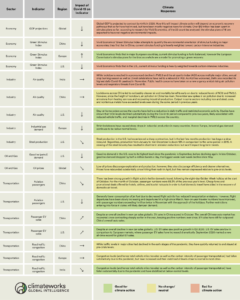
We are nearly one year into the Covid-19 pandemic. Despite initial rollout of the much awaited Covid-19 vaccine, nations continue to struggle with containment of the pandemic, and many countries have reverted to some form of lockdown in anticipation of the approaching holiday season.
As we wrote earlier this year, Covid-19’s impact on the climate has yet to be written — but we now have a better idea of the near-term and long-term implications. Throughout the year, ClimateWorks has monitored a set of key climate-related indicators that have been affected by Covid-19. Here, we highlight significant Covid-19 impacts on key sectors and assess the implications for sustained climate action.
Will industry rebound?

At the beginning of the pandemic, we saw strict lockdowns cause sharp drops in industrial production in many countries. Today, the overall outcome is still a bit murky. In China, industrial output in 2020 is now outpacing 2019, and emissions from steelmaking in particular have risen in part due to government stimulus measures. China’s economy has benefited from its relative success in controlling its Covid-19 outbreak. However, the country’s public health success may be insufficient to revive its economy while major trading partners are still in recession. South Korea and Vietnam both fit this description and point to a continued suppression in industrial activity through the first half of 2021, at least until widespread vaccination occurs. In the long run, however, economic activity (and hence greenhouse gas emissions) will rebound, and the most consequential impact of the pandemic will be how historically large government stimulus measures will be spent.
Oil prices trend down, clean transportation trends up
After plunging in March and April, oil markets rebounded slightly in the third quarter of 2020. While consumption has risen from its lowest point, demand remains well below historical levels, and prices continue to stagnate at less than $50 per barrel. The CEOs of BP and Shell have warned that 2019 might represent peak oil demand and some even proclaimed the “end of the oil age.”
Low oil prices do not seem to be slowing the global momentum toward transportation electrification, as evident through the most recent news that Québec and the U.K. joined a growing number of governments accelerating the transition to 100% electric vehicles (EVs, including hybrids, plug-in hybrids, and full battery power). Europe took the lead in annual EV sales globally, driving forward efforts to catch up with China. Germany finally emerged as one of the continent’s hottest EV markets, and in the first seven months of 2020, Europe claimed the global EV sales lead by surpassing China’s EV sales by 14,000 units. Despite an overall plunge in new car sales in Europe, EV sales grew in percentage and absolute terms, accounting for 8% of all sales, double the market share compared to the same period in 2019. In July, EVs reached an all-time high of 18% of the total European passenger car market.
Lastly, the easing of Covid-19 restrictions led to a rebound in traffic congestion as a portion of public transit trips shifted to private vehicles due to safety concerns. This trend was also accompanied by a rise in shared and private micromobility (bicycles and e-scooters) trips, as well as a major uptick in bicycle sales across the U.S. and Europe.
Government response to the crisis
Governments around the world have passed a variety of fiscal stimulus measures meant to blunt the economic impact of the recession caused by the Covid-19 pandemic. Some policy packages, such as the European Green Deal, have used this as an opportunity to build back better, making climate change mitigation one of the main priorities of their Covid-19 recovery. However, research by Vivid Economics has shown that of over $12 trillion spent in stimulus plans by 22 countries,18 of them are expected to have negative environmental impacts on net. Particularly egregious were the bailouts of airlines without any environmental conditions, a major missed opportunity and a demonstration of the lobbying power of incumbent industries at the expense of the low-carbon transition.
Sustaining emissions reductions after the pandemic
Global carbon dioxide emissions have been rising for five decades. 2020 will break that trend, with emissions projected to decline by around 7% or 8% relative to 2019 — but for all the wrong reasons. While Covid-19 has reduced economic production and personal mobility, and thus greenhouse gas emissions, we are already seeing emissions rebounds in countries that have gotten the pandemic relatively under control.
Going forward, we need to sustain a similar rate of emissions decline year over year for the rest of the decade to get back on track to reach the goals of the Paris Agreement, but analysts expect that emissions in 2021 will rebound. This should send a strong message that activity declines are insufficient to achieve a safe long-term climate. In order to move toward decarbonization in a post-pandemic world, we need to reduce the greenhouse gas intensity of human activities and begin to remove carbon from the atmosphere at scale in order to reach net-zero emissions by midcentury.
Implications of converging crises
In addition to a health and economic crisis of epic proportions, we are still hurtling towards temperature rise in excess of 3° C this century, which will likely have devastating consequences for people and the planet. While climate change and global health policy have largely been treated as separate issues by the public and media up to this point, the causes of both crises share commonalities, and their effects are converging. For example, we are seeing that the links between climate change, air pollution, and Covid-19 are at this point indisputable. A recent study showed that an increase of only one microgram per cubic meter in PM2.5 — fine particulate matter that is released in addition to greenhouse gases when burning fossil fuels — is associated with an 8% increase in the Covid-19 death rate. There is increasing evidence that both Covid-19 and the climate crisis disproportionately impact the poorest and most marginalized people in society, and both crises contribute to widening inequality.
The warming climate will play a bigger role in future pandemics, and moving forward, we must look toward more integrated solutions in responding to converging crises. According to the 2020 U.N. Environment Programme Gap Report, a low-carbon pandemic recovery could cut 25% of greenhouse gas emissions. Seizing this opening is critical to bridging the emissions gap. As we’ve seen, reductions in activity levels and energy consumption have resulted in real reductions in emissions. However, this is a solution that offers only short-term respite. Long-run deep decarbonization beyond the pandemic requires ambitious policies that drive emissions from our daily activities toward zero. Only then will we have a chance of meeting the Paris Agreement’s long-term goal of net-zero global greenhouse gas emissions by midcentury.
For more information on how ClimateWorks is responding to the Covid-19 pandemic, see here.


